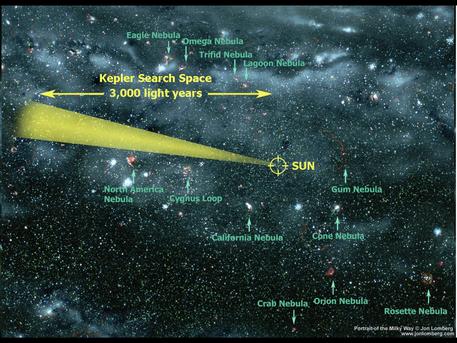New space telescope Kepler
A telescope in search for a "Second Earth"
 © Jon Lomberg, NASA
|
An artists rendering of what our galaxy might look as viewed from outside our Galaxy. Our sun is about 25,000 light years from the center of the galaxy. The cone illustrates the neighborhood of our galaxy that the Kepler Mission will search to find habita
- » 1 - Search for habitable planets
- » 2 - Twelve times the light of Corot
Search for habitable planets
100.000 stars at a glance
The undivided attention of Kepler is focused on the 100,000 stars of the two constellations Cygnus and Lyra. Twice every hour 42 light sensitive chips, so called CCDs, will register their brightness. With all in all 95 megapixels it will be the biggest "digital camera" ever sent to space. If invisible exoplanets orbit around stars, they will reveal themselves by a slight dim out for a few hours. This will happen when the darker planet passes in front of the star from Kepler's perspective. Known as the transit method, it is a part of the repertoire of exoplanet chasers: it is used in observatories as well as space telescopes.New space telescope Kepler
A telescope in search for a "Second Earth"
 © Jon Lomberg, NASA
|
An artists rendering of what our galaxy might look as viewed from outside our Galaxy. Our sun is about 25,000 light years from the center of the galaxy. The cone illustrates the neighborhood of our galaxy that the Kepler Mission will search to find habita
- » 1 - Search for habitable planets
- » 2 - Twelve times the light of Corot












